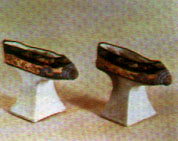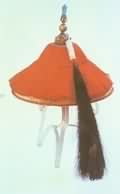
Qixie(Manchu shoes): ancestors of the Manchu had a convention of "making shoes out of wood". By the early Qing Dynasty (1644-1911), their shoes had developed into the high-heeled female shoes of wooden treads: those in the shape of a flowerpot were called "flowerpot shoes", and those in shape of a horse's hoof were called "horse hoof-tread" shoes.
The Manchu shoes for aged women had a piece of flat wood as the tread, called "flat-tread shoes ". Usually, there were colorized brims or bead string patterns on both the upper and the vamp. The Manchu had a custom of females wearingQixie(Manchu shoes) and males wearing boots. Officials wore square-toed boots, and commoners wore pointed-toed boots. Materials of the boots include satin, woven silks, cloth and leather, etc.
Among the Manchu civilians, men liked to wearWulaxie: a kind of shoes made of animal skin and wadded withWulacao(a soft grass growing in northeast China), which is very light and warm and suitable for hunting and running on the ice in winter.

Dingdai Hualingwas a kind of hat used to indicate one's official rank in the Qing Dynasty.Dingdai, commonly called "Dingzi", was decorated with colorful gemstones and gold to show the official rank, and on it were some inserted plumes, hence the name "Dingdai Hualing". Such a convention of adornment was a relic of the ancient custom of wearing stones and plumes of the Nuchen people (ancestors of the Manchu).
The Manchu people, whether male or female, old or young, have the habit of wearing a cap in all seasons. Men wear a hat or an umbrella-shaped grass cap in spring and summer, and a warm cap, especially a fur felt hat, in autumn and winter. For women, they like to wear a cool cap or a flat-bottomed cap in ordinary life. Aged women in winter wear "Erbao"(ear covers) or "Naobao" (head covers), etc.
The Manchu respect the dog, so it is prohibited to wear caps and raglan sleeves made of dogskin.



